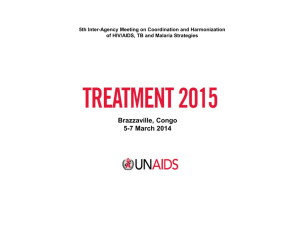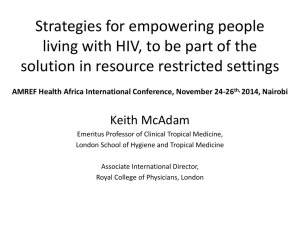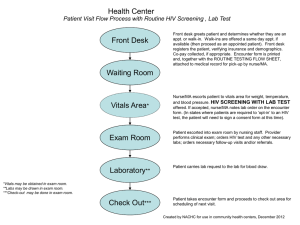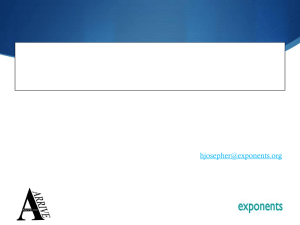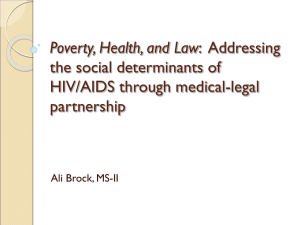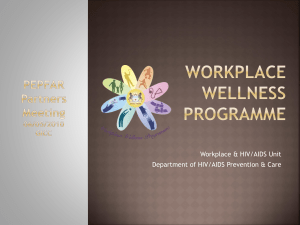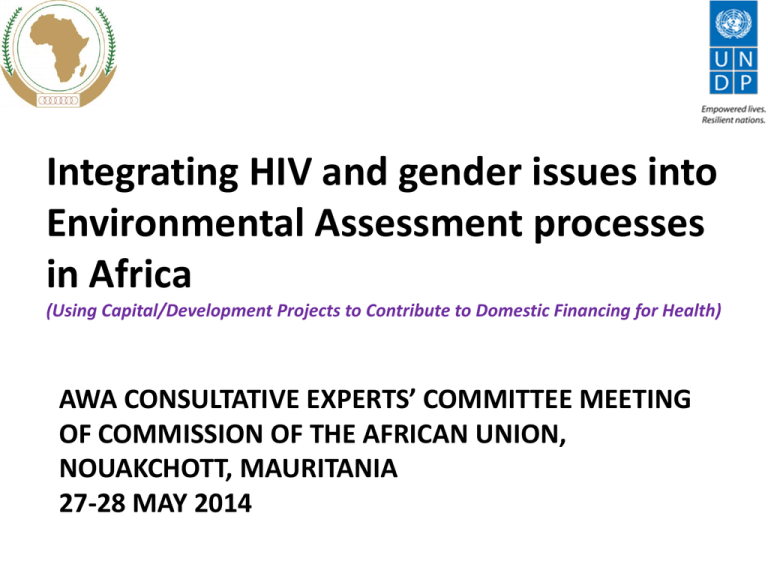
Integrating HIV and gender issues into
Environmental Assessment processes
in Africa
(Using Capital/Development Projects to Contribute to Domestic Financing for Health)
AWA CONSULTATIVE EXPERTS’ COMMITTEE MEETING
OF COMMISSION OF THE AFRICAN UNION,
NOUAKCHOTT, MAURITANIA
27-28 MAY 2014
Presentation outline
1
Introduction
2
Using EA to Mitigate the Impacts of Capital development on HIV
3
The UNDP/African Development Bank Project
4
Progress on Using Env. Assessments to Mitigate HIV Impacts in Africa
5
Challenges and Way Forward
6
Recommendations
Introduction 1:
HIV in Africa
69% of the 34 million people living with HIV globally live in
Africa
More than 13.5 million people living with HIV in SADC region
alone
37% of female sex workers in Africa are estimated to be living
with HIV
Current challenges include:
o Low uptake of HIV testing,
o Need for innovative HIV prevention services
o Need for sustainability of funding
o Addressing the long term structural drivers including
migration, stigma and discrimination and weak laws
Interest is now growing in relation to the linkages between
increasing HIV infections and large infrastructure projects
3
Introduction 2:
Capital Projects Development in Africa
At the same time:
Africa is experiencing a boom in the development of its resources
for which large capital projects are pre-requisites
Large infrastructure projects feature in most NDPs e.g.
South Africa’s $113 billion infrastructure Plan
Angola’s transport infrastructure plan
Mozambique’s development of its oil and natural gas resources
Uganda’s oil discoveries in the Albertine Rift Valley
South Sudan’s plans to improve trade and oil export corridors
through Uganda and Kenya
Botswana’s planned trans-Kalahari railway
Cameroon’s mega seaport in Kiribi
Tanzania’s road upgrades to the port of Mtwara
Zambia’s construction of the Kazungula Bridge and Link Zambia
8000
Nigeria’s 113B railway expansion project
Implementation of the EAC priority Projects
4
Introduction 3:
Links between HIV & Capital Development in Africa
Initial reports linking large capital projects and HIV were from the
Asian Development Bank and the Great Mekong region but are
corroborated by recent studies by IOM and by other studies in
Africa
Execution of road networks can be an HIV vulnerability factor
i.e. Nacala corridor in northern Mozambique
In the extractive industry, migrant miners in South Africa (3044 age group) estimated to be 15% more likely to be HIV
positive
A woman whose partner is a migrant miner was 8% more likely
to become HIV infected
A study of the HIV prevalence in the coal-mining province of
Tete in Mozambique showed an increase of 80% between 2009
and 2011
Niger Delta is one of the most highly affected regions in Nigeria
for HIV. Two of the three states that experienced a more than
100% increase in sero-prevalence rates between 1991 and
1997 were in the Niger Delta where oil is produced.
5
Introduction 4:
Links between HIV & Capital Development in Africa
The construction of the Khatse dam in Lesotho played
a significant role in the spread of HIV e.g. in Leribe,
considered to be the gateway to the LHWP, infection
rate amongst 15-24 year olds rose from 3% in 1991 to
12.6% in 1993
By 1999, tests for antenatal women living in the
villages around the Khatse Dam indicated that 22%
were HIV positive
In South Africa, the construction of the Madupe
nuclear power plant has coincidentally seen a rise in
new HIV infections in the Waterberg district 23% to
30.3% in 2011.
6
Using EA to Mitigate the Impacts Capital
Development on HIV
Three Key Messages………
We can take advantage of the “construction boom” and the
relatively large resources attached to them, to mitigate health risks
that might be associated with them
To do that we need to improve the ability of all stakeholders
(decision makers, politicians, regulatory authorities, developers,
health and gender experts, civil society and the community, etc.) to
better predict social impacts, particularly those related to HIV and
gender associated with such projects
With integrated design and implementation of interventions, we
can help to maximize the benefits of such developments whilst
mitigating against negative consequences
In the context of raising additional domestic financing for HIV Environmental and Social
Assessment Process is the only legally approved tool in all countries to do that.
7
EA soup
The Environmental Assessment Soup
SEF
:
k
r
ew o
m
a
r S
S tra te g ic P ro c e sse s fo r S u sta in a b ility
ta l F
tr a te
n
e
n t:R E A
e
m
m
s
g
s
n
e
s
i
s
o
c Im
S tr n v ir
Cou
m e n ta l A
n
o
r
p
i
E
a
v
n
a
n
E
c
t
l
egi
tr y E R e g io n a c t A s
te g i
c O
sess
n v ir
S tr a
ver
m en
o
t
n
m
v ie e n
t: S I
e
n ta l
w
A
m
t
A
s
n
s
IA
s
s
e
:
e
s
t
e
s
m
n
msemne
s
ss
t: C E
e
A ssse ssm e n A
S tr
P o v e rty Im p a c tt A
t: sPs eIA
s s
s
a
A
a te
c
d
e
e
t
a
d
a
g
r
a
p
t e gi c E n
Tr
m
n
A
I
I
d
EA
e in a b ility a p p ra isa l: S A
vn
E
S
tsta
:
e
i
S
u
a
t
r
S
r
v
eg
sm e onm e
N
s
t
e
a ti
s
n
l
s
I
A
n
A
u
ta l
e n t t a l An t :
n
m
e
m
s
m
u
s
e nal
sse
C
v ir o n
A
m
n
l
ysi
a
E
s
nt
c
i
e
s
s
g
m
e
t
e
n
In te
a
o
r
r
s
t
i
S
v P a r ti c ip
s
g ra
a to r y P o v e
l En
A
te d
a
r
o
Env
ic rty A s s e s s m e n t
S ect P o
g
i rlo n
v e r ty
te
a
m en
and S
s
a
i
r
a
o c iS
ta l
a tl I m p
ppr
A
A
act A
sses
al
ssessm
ic y
l
c
s
m
i
o
e n t: P
P
e n t: y t
S IA
l
I
E n e rg y a n d E n v iro n m enna t E
RM
e v ie w s : E E R
A
8
Using EA to Mitigate the Impacts Capital
Development on HIV
EA is a proactive tool used for identifying, predicting,
evaluating and mitigating the relevant negative effects
of large capital (development) projects prior to making
decisions (Includes Environmental, Social and Health
Impact Assessments)
Provides decision-makers with a holistic and informed
opinion based on sound and objective research and
analysis of how such projects may render whole
communities vulnerable.
There are 5 main stages of the Environmental
Assessment Process are good entry points where
stakeholders can make strategic contributions in
support of national AIDS responses.
9
Using EA to Mitigate the Impacts Capital
Development on HIV
Screening: Assessment of whether a large capital project requires an environmental
assessment or not and at what level (Usually by the NEMA and line ministry involved)
Scoping: Scoping is the process of determining the issues to be addressed, the information to
be collected, and the analysis required to assess the environmental and social impacts of the
project.
Environmental Impact Assessment: As the administrative or regulatory process by which the
environmental impact of a project is determined in a systematic and scientific manner
Environmental Management Plan: Management and mitigation measures are implemented
on the ground through a well formulated Environmental Management Plan (EMP)
Environmental Monitoring: activities undertaken by a company or contractor during project
construction and operation to monitor its effects on the environment
10
The UNDP/AfDB Project
Recognising that the EA process can provide a proactive opportunity for up-scaling HIV
prevention efforts, UNDP in partnership with ILO, IOM and AfDB have initiated a project aimed
at integrating health (HIV) and Gender issues in EAs in Africa.
The objective are:
To increase the awareness of decision makers, civil society and environmental assessment
practitioners
To assist officials who plan, administer and manage impact assessments to also consider
health (HIV) & gender
To assist environmental assessment practitioners to work closely with NACs, MoH, Gender
related institutions, human rights organizations, CSOs and NGOs in properly assessing HIV
and gender impacts
To strengthen existing legal and institutional frameworks and EA practice to ensure that HIV
and gender-related issues are integrated into EAs
This multi-country initiative contributes to Pillar One of the AU Road Map in terms of
identifying more diversified, balanced and sustainable models of financing.
11
Progress on Using EAs to Mitigate HIV Impacts in
Africa
Advocacy workshops held in 8 ESA countries (2011)
Institutional self-assessments were conducted in six countries
(Botswana, Lesotho, Namibia, Malawi, Uganda and Zambia)
(2011)
Development of a guideline launched jointly by UNDP & AfDB
4 ToT sessions conducted for 170 participants from 10 countries
(2012/2013)
80 EIA experts have been trained in partnership with IAIASA
(2013)
50 national/private sector personnel trained in Mozambique
CSO sectors of SANAC trained (2014)
Legislative environments strengthened in the 8 countries in ESA
(Botswana, Burkina Faso, Lesotho, Malawi, Mozambique,
Namibia, South Africa, Uganda & Zambia) (2011-2014)
Six countries (Lesotho, Malawi, Mozambique, Namibia, South
Africa and Uganda) have either completed a law reform or in the
12
process (2012/2014)
Progress on Using EAs to Mitigate HIV Impacts in Africa
Country
Botswana
Burkina Faso
Lesotho
Malawi
Mozambique
Namibia
South Africa
Uganda
Zambia
Progress
Formation of an integrated task team FOR Environmental Monitoring
Integrating HIV/Gender issues into UB curriculum for EA practitioners
Initiated national policy reforms to include HIV and gender guidance in its EIA Guidelines for the mining
sector
Alignment of national guidelines & regulations to account for HIV and gender issues.
Capacity strengthened at the National Environmental Management Authority leading to improved analysis
and assessment of HIV and gender impacts in current EIA reports.
HIV and gender clauses inserted into the newly developed Environmental Management Act.
Process to review and reform current national guidelines underway
Mobilization of the International Association of Impact Assessments Mozambique
Ongoing training of national/provincial EIA managers
Partnership with Geography Department of Eduardo Mondlane University
Using the institutional assessment tool (The Environmental Assessment Barometer for Africa) to assess
current strengths and weaknesses in Namibia’s EA policy and practice.
CSO Training on their role in public consultation processes and M&E (SANAC)
Mapping of nationally planned large capital projects for use as case studies.
Training of environmental and social impact assessment practitioners with IAIAsa.
Guidelines integrated into the curriculum of the University of the North West and used to train EIA graduates.
Revision of National Guidelines on EIA to include guidance on HIV and gender issues.
Drafting of specific EIA guidelines for the mining, energy and fishing sectors.
Initiated a process of jointly reviewing the Kazungola Bridge Project EIA report to determine the extent to
which HIV and gender considerations have been factored into the project and to develop a cross border
response with Namibia, Zimbabwe and Botswana.
13
Challenges and Way Forward
Challenges
Way Forward
Awareness-raising at Africa Union & RECs’
Weak understanding of and a lack of
level
willingness by developers to invest in social
interventions
Advocacy & Capacity Building for country
and regional stakeholders
Confusion on the role of developers,
government and civil society in terms of
the planning, programming &execution of Strong partnerships between UNDP, AfDB
and the AUC, UNEP, ILO, IOM, WHO,RECS
social intervention related to EA
Lack of general indicators to monitor social
impacts and interventions within the EIA
process
Weak accountability mechanisms
Revamping inter-ministerial committees on
environment
Promote research to generate and share
knowledge
14
Recommendations
(Contribute to Domestic Financing for Health)
African Union Commission and the Regional Economic Communities work with Member
States to:
o Facilitate advocacy at the highest levels of government and through relevant AUC
structures e.g. the AMCEN to raise awareness on the links between infrastructure
development and HIV/Gender vulnerability.
o Facilitate advocacy and research so that developers and governments recognise social
interventions around large capital projects as investments rather than as mere
expenditures.
o Help develop continental wide indicators that can be adapted and used by national
governments and developers to monitor social interventions associated with large
capital projects.
o Promote accountability within the EIA process by helping to:
strengthen CSO and community engagement in public participation;
formulate evidence informed mitigation measures; iii) tighten compliance auditing and
monitoring to make sure that the EMPs are fully implemented; and iv) ensure that
allocated funds attached to large capital projects are effectively planned for and
monitored.
15
Thank You
benjamin.ofosu-kooranteng@undp.org
Acknowledgements:
a. Bryony Walmsley (Southern African Institute for Environmental Assessments)
b. Peter Tarr ((Southern African Institute for Environmental Assessments)
c. UNDP HIV, Health and Development Team (Addis Ababa)
d. Rosemary Kumwenda (UNDP Malawi)
16


